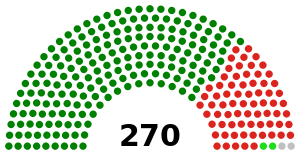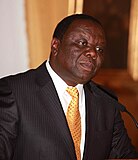Zimbabwean general election, 2013
|
|
|||||||||||||||||
|---|---|---|---|---|---|---|---|---|---|---|---|---|---|---|---|---|---|
|
|||||||||||||||||
|
|||||||||||||||||

Composition of the House of Assembly
|
|||||||||||||||||
|
|||||||||||||||||
General elections were held in Zimbabwe on 31 July 2013. The incumbent President, Robert Mugabe, was re-elected, whilst his Zimbabwe African National Union – Patriotic Front party won a two-thirds majority in the House of Assembly.
This was the first election held under the new constitution approved in a referendum in March 2013 and signed into law by President Robert Mugabe on 22 May. The Supreme Court ruled on 31 May that President Mugabe should set a date as soon as possible, and that presidential and parliamentary elections must be held by 31 July. The ruling followed an application to the court by a Zimbabwean citizen, Jealousy Mawarire, demanding that the country's president set the date for elections before the expiry of the tenure of the seventh parliament, on 29 June 2013. Under the new constitution the winner of the presidential election will serve a five-year term.
Most of Zimbabwe's 2010 districts had candidates from all of the three major parties: ZANU-PF, one of the two formulations of the MDC, and ZAPU. Minor party candidates and independents rounded out the field in some districts.
In accepting the election date, Tsvangirai said that reforms should have preceded the election, as he began his election campaign. He also claimed that the country wanted to vote Mugabe out. Launching his election campaign, Mugabe called it "a do or die struggle" while making a strong appeal for a peaceful campaign. In the same speech, he warned that he could take Zimbabwe out of SADC "if SADC decides to do stupid things". Although there were initial discussions about forming a grand coalition between the two MDC parties and other opposition parties, by 9 July two separate coalitions had been formed, one comprising MDC-T, Mavambo/Kusile/Dawn and ZANU-Ndonga, and the other coalition comprising MDC and ZAPU.
...
Wikipedia


